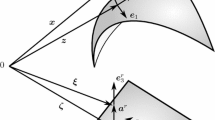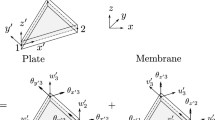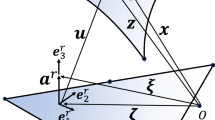Abstract
Meshless methods provide a highly continuous approximation field, convenient for thin structures like shells. Nevertheless, the lack of Kronecker Delta property makes the formulation of essential boundary conditions not straightforward, as the trial and test fields cannot be tailored to boundary values. Similar problem arise when different approximation regions must be joined, in a multi-region problem, such as kinks, folds or joints. This work presents three approaches to impose both kinematic conditions: the well-known Lagrange multiplier method, used since the beginning of the element free Galerkin method; a pure penalty approach; and the recently rediscovered alternative of Nitsche’s method. We use the discretization technique for thick Reissner–Mindlin shells and adapt the weak form as to separate displacement and rotational degrees of freedom and obtain suitable and separate stabilization parameters. This approach enables the modeling of discontinuous shells and local refinement on multi-region problems.






















Similar content being viewed by others
References
Annavarapu C, Hautefeuille M, Dolbow JE (2012) A robust Nitsche’s formulation for interface problems. Comput Methods Appl Mech Eng 225–228:44–54. doi:10.1016/j.cma.2012.03.008
Annavarapu C, Hautefeuille M, Dolbow JE (2012) Stable imposition of stiff constraints in explicit dynamics for embedded finite element methods. Int J Numer Methods Eng 92(2):206–228. doi:10.1002/nme.4343
Annavarapu C, Hautefeuille M, Dolbow JE (2013) A Nitsche stabilized finite element method for frictional sliding on embedded interfaces. Part II: intersecting interfaces. Comput Methods Appl Mech Eng 267:318–341. doi:10.1016/j.cma.2013.08.008
Annavarapu C, Hautefeuille M, Dolbow JE (2014) A Nitsche stabilized finite element method for frictional sliding on embedded interfaces. Part I: single interface. Comput Methods Appl Mech Eng 268:417–436. doi:10.1016/j.cma.2013.09.002
Belytschko T, Lu YY, Gu L (1994) Element-free Galerkin methods. Int J Num Methods Eng 37(2):229–256. doi:10.1002/nme.1620370205
Belytschko T, Organ D, Krongauz Y (1995) A coupled finite element-element-free Galerkin method. Comput Mech 17(3):186–195. doi:10.1007/BF00364080
Belytschko T, Krongauz Y, Organ D, Fleming M, Krysl P (1996) Meshless methods: an overview and recent developments. Comput Methods Appl Mech Eng 139(1–4):3–47. doi:10.1016/S0045-7825(96)01078-X
Bitencourt LAG Jr, Manzoli OL, Prazeres PGC, Rodrigues EA, Bittencourt TN (2015) A coupling technique for non-matching finite element meshes. Comput Methods Appl Mech Eng 290:19–44. doi:10.1016/j.cma.2015.02.025
Campello EM, Pimenta PM, Wriggers P (2003) A triangular finite shell element based on a fully nonlinear shell formulation. Comput Mech 31(6):505–518. doi:10.1007/s00466-003-0458-8
Chen JS, Wang D (2006) A constrained reproducing kernel particle formulation for shear deformable shell in Cartesian coordinates. Int J Numer Methods Eng 68(2):151–172. doi:10.1002/nme.1701
Cirak F, Ortiz M, Schröder P (2000) Subdivision surfaces: a new paradigm for thin-shell finite-element analysis. Int J Numer Methods Eng 47(12):2039–2072. doi:10.1002/(SICI)1097-0207(20000430)47:12<2039::AID-NME872>3.0.CO;2-1
Cordes LW (1080) Moran B (1996) Treatment of material discontinuity in the element-free Galerkin method. Comput Methods Appl Mech Eng 139(1–4):75–89. doi:10.1016/S0045-7825(96)01080-8
Costa JC, Tiago CM, Pimenta PM (2013) Meshless analysis of shear deformable shells: the linear model. Comput Mech 52(4):763–778. doi:10.1007/s00466-013-0837-8
Dolbow J, Harari I (2009) An efficient finite element method for embedded interface problems. Int J Numer Methods Eng 78(2):229–252. doi:10.1002/nme.2486
Embar A, Dolbow J, Harari I (2010) Imposing Dirichlet boundary conditions with Nitsche’s method and spline-based finite elements. Int J Numer Methods Eng 83(7):877–898. doi:10.1002/nme.2863
Fernández-Méndez S, Huerta A (2004) Imposing essential boundary conditions in mesh-free methods. Comput Methods Appl Mech Eng 193(12–14), 1257–1275 doi:10.1016/j.cma.2003.12.019. Meshfree methods: recent advances and new applications
Fernández-Méndez S, Bonet J, Huerta A (2005) Continuous blending of SPH with finite elements. Comput Struct 83(17–18):1448–1458. doi:10.1016/j.compstruc.2004.10.019
Fritz A, Hüeber S, Wohlmuth BI (2004) A comparison of mortar and Nitsche techniques for linear elasticity. CALCOLO 41(3):115–137. doi:10.1007/s10092-004-0087-4
Griebel M, Schweitzer MA (2003) A particle-partition of unity method. Part V: boundary conditions. In: Hildebrandt S, Karcher H (eds) Geometric analysis and nonlinear partial differential equations. Springer, Berlin, pp 519–542. doi:10.1007/978-3-642-55627-2_27
Guo Y, Ruess M (2015) A layerwise isogeometric approach for NURBS-derived laminate composite shells. Compos Struct 124:300–309. doi:10.1016/j.compstruct.2015.01.012
Guo Y, Ruess M (2015) Nitsche’s method for a coupling of isogeometric thin shells and blended shell structures. Comput Methods Appl Mech Eng 284:881–905. doi:10.1016/j.cma.2014.11.014
Guo Y, Ruess M (2015) Weak Dirichlet boundary conditions for trimmed thin isogeometric shells. Comput Math Appl. doi:10.1016/j.camwa.2015.06.012
Hansbo A, Hansbo P (2002) An unfitted finite element method, based on Nitsche’s method, for elliptic interface problems. Comput Methods Appl Mech Eng 191(47–48):5537–5552. doi:10.1016/S0045-7825(02)00524-8
Harari I, Dolbow JE (2010) Analysis of an efficient finite element method for embedded interface problems. Comput Mech 46(1):205–211. doi:10.1007/s00466-009-0457-5
Harari I, Grosu E (2015) A unified approach for embedded boundary conditions for fourth-order elliptic problems. Int J Numer Methods Eng 104(7):655–675. doi:10.1002/nme.4813
Harari I, Shavelzon E (2012) Embedded kinematic boundary conditions for thin plate bending by Nitsche’s approach. Int J Numer Methods Eng 92(1):99–114. doi:10.1002/nme.4337
Hautefeuille M, Annavarapu C, Dolbow JE (2012) Robust imposition of Dirichlet boundary conditions on embedded surfaces. Int J Numer Methods Eng 90(1):40–64. doi:10.1002/nme.3306
Huerta A, Fernández-Méndez S (2000) Enrichment and coupling of the finite element and meshless methods. Int J Numer Methods Eng 48(11):1615–1636. doi:10.1002/1097-0207(20000820)48:11<1615::AID-NME883>3.0.CO;2-S
Huerta A, Fernández-Méndez S, Liu WK (2004) A comparison of two formulations to blend finite elements and mesh-free methods. Comput Methods Appl Mech Eng 193(12–14):1105–1117. doi:10.1016/j.cma.2003.12.009. Meshfree methods: recent advances and new applications
Ivannikov V, Tiago C, Pimenta PM (2014) Meshless implementation of the geometrically exact Kirchhoff–Love shell theory. Int J Numer Methods Eng 100(1):1–39. doi:10.1002/nme.4687
Ivannikov V, Tiago C, Pimenta PM (2014) On the boundary conditions of the geometrically nonlinear Kirchhoff–Love shell theory. Int J Solids Struct 51(18):3101–3112. doi:10.1016/j.ijsolstr.2014.05.004
Jiang W, Annavarapu C, Dolbow JE, Harari I (2015) A robust Nitsche’s formulation for interface problems with spline-based finite elements. Int J Numer Methods Eng. doi:10.1002/nme.4766
Krongauz Y, Belytschko T (1996) Enforcement of essential boundary conditions in meshless approximations using finite elements. Comput Methods Appl Mech Eng 131(1–2):133–145. doi:10.1016/0045-7825(95)00954-X
Krongauz Y, Belytschko T (1998) EFG approximation with discontinuous derivatives. Int J Numer Methods Eng 41(7):1215–1233. doi:10.1002/(SICI)1097-0207(19980415)41:7<1215:AID-NME330>3.0.CO;2
Krysl P, Belytschko T (1996) Analysis of thin shells by the element-free Galerkin method. Int J Solids Struct 33(20–22):3057–3080. doi:10.1016/0020-7683(95)00265-0
Li S, Liu WK (2004) Meshfree particle methods. Springer, Berlin. doi:10.1007/978-3-540-71471-2
Li S, Hao W, Liu WK (2000) Numerical simulations of large deformation of thin shell structures using meshfree methods. Comput Mech 25(2–3):102–116. doi:10.1007/s004660050463
Liu GR (2010) Mesh free methods: moving beyond the finite element method. CRC Press. http://books.google.de/books?id=dHKYBOYVb2gC
Liu GR, Gu YT (2005) An introduction to meshfree methods and their programming. Springer, Dordrecht. doi:10.1007/1-4020-3468-7
Lu Y, Belytschko T, Gu L (1994) A new implementation of the element free Galerkin method. Comput Methods Appl Mech Eng 113(3–4):397–414. doi:10.1016/0045-7825(94)90056-6
Lu Y, Belytschko T, Tabbara M (1995) Element-free Galerkin method for wave propagation and dynamic fracture. Comput Methods Appl Mech Eng 126(1–2):131–153. doi:10.1016/0045-7825(95)00804-A
Nayroles B, Touzot G, Villon P (1992) Generalizing the finite element method: diffuse approximation and diffuse elements. Comput Mech 10(5):307–318. doi:10.1007/BF00364252
Nguyen VP, Kerfriden P, Brino M, Bordas SPA, Bonisoli E (2014) Nitsche’s method for two and three dimensional NURBS patch coupling. Comput Mech 53(6):1163–1182. doi:10.1007/s00466-013-0955-3
Nitsche J (1971) Über ein Variationsprinzip zur Lösung von Dirichlet-Problemen bei Verwendung von Teilräumen, die keinen Randbedingungen unterworfen sind. Abhandlungen aus dem Mathematischen Seminar der Universität Hamburg 36(1):9–15. doi:10.1007/BF02995904
Noguchi H, Kawashima T, Miyamura T (2000) Element free analyses of shell and spatial structures. Int J Numer Methods Eng 47(6):1215–1240. doi:10.1002/(SICI)1097-0207(20000228)47:6<1215::AID-NME834>3.0.CO;2-M
Pimenta PM, Campello EM (2009) Shell curvature as an initial deformation: a geometrically exact finite element approach. Int J Numer Methods Eng 78(9):1094–1112. doi:10.1002/nme.2528
Ruess M, Schillinger D, Bazilevs Y, Varduhn V, Rank E (2013) Weakly enforced essential boundary conditions for NURBS-embedded and trimmed NURBS geometries on the basis of the finite cell method. Int J Numer Methods Eng 95(10):811–846. doi:10.1002/nme.4522
Ruess M, Schillinger D, Özcan AI, Rank E (2014) Weak coupling for isogeometric analysis of non-matching and trimmed multi-patch geometries. Comput Methods Appl Mech Eng 269:46–71. doi:10.1016/j.cma.2013.10.009
Sala-Lardies E, Fernández-Méndez S, Huerta A (2012) Optimally convergent high-order X-FEM for problems with voids and inclusions. In: ECCOMAS 2012—European Congress on Computational Methods in Applied Sciences and Engineering. e-Book Full Papers, pp 8080–8093. http://hdl.handle.net/2117/17031
Sanders JD, Puso MA (2012) An embedded mesh method for treating overlapping finite element meshes. Int J Numer Methods Eng 91(3):289–305. doi:10.1002/nme.4265
Sanders JD, Dolbow JE, Laursen TA (2009) On methods for stabilizing constraints over enriched interfaces in elasticity. Int J Numer Methods Eng 78(9):1009–1036. doi:10.1002/nme.2514
Sanders JD, Laursen TA, Puso MA (2012) A Nitsche embedded mesh method. Comput Mech 49(2):243–257. doi:10.1007/s00466-011-0641-2
Simo J, Hughes T (1998) Computational Inelasticity. Interdisciplinary applied mathematics: mechanics and materials. Springer. http://books.google.de/books?id=ftL2AJL8OPYC
Simo JC, Fox DD, Rifai MS (1989) On a stress resultant geometrically exact shell model. Part II: the linear theory; computational aspects. Comput Methods Appl Mech Eng 73(1):53–92. doi:10.1016/0045-7825(89)90098-4
Stenberg R (1995) On some techniques for approximating boundary conditions in the finite element method. J Comput Appl Math 63(1–3):139–148 doi:10.1016/0377-0427(95)00057-7. In: Proceedings of the international symposium on mathematical modelling and computational methods modelling 94
Tiago CM (2007) Meshless methods: extending the linear formulation and its generalization to geometrically exact structural analysis. PhD thesis, Instituto Superior Técnico, Universidade Técnica de Lisboa
Wriggers P, Zavarise G (2008) A formulation for frictionless contact problems using a weak form introduced by Nitsche. Comput Mech 41(3):407–420. doi:10.1007/s00466-007-0196-4
Acknowledgments
The first author would like to thank CNPq (Conselho Nacional de Desenvolvimento Tecnológico) for his PhD grant and CAPES (Coordenação de Aperfeiçoamento de Pessoal de Nível Superior) for supporting his exchange stay at the Leibniz University of Hannover. The second author acknowledges the support of the CNPq under the grant 303091/2013-4 as well as expresses his gratitude to the Alexander von Humboldt Foundation for the Georg Forster Research Award that made possible his stay at the University of Duisburg-Essen and the Leibniz University of Hannover. Also, we thank Prof. Carlos Tiago, at Instituto Superior Técnico, Lisbon for many proficuous conversations on the subject.
Author information
Authors and Affiliations
Corresponding author
Rights and permissions
About this article
Cite this article
Costa, J.C., Pimenta, P.M. & Wriggers, P. Meshless analysis of shear deformable shells: boundary and interface constraints. Comput Mech 57, 679–700 (2016). https://doi.org/10.1007/s00466-015-1253-z
Received:
Accepted:
Published:
Issue Date:
DOI: https://doi.org/10.1007/s00466-015-1253-z




